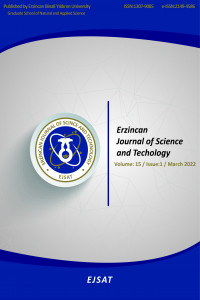Öz
Kaynakça
- Aksoy M.A., 2019. Analysing of Electromagnetic shielding effectiveness on glass surfaces covered with conductive metal oxide, Atatürk University, Graduate School of Natural and Applied Sciences, Department of Electrical and Electronics Engineering, Department of Electromagnetic Fields and Microwave Technology, Master Thesis, p.55.
- Altun M., Karteri İ., Güneş M., Alma M.H., 2017. Comparative Study of Electromagnetic Properties and Electromagnetic Shielding Effectiveness of Graphene Based Wood Plastic Nanocomposites, KSU Journal of Engineering Sciences, 20(1), 38-47.
- Al-Saleh, M.H., Sundararaj, U. 2013. X-band EMI Shielding Mechanisms and Shielding Effectiveness of High Structure Carbon Black/Polypropylene Composites, J. Phys. D 46, 35304.
- Abdulla R., 2016. Investigation of electromagnetic shielding efficiency of woven and knitted fabrics of different structures and properties, Süleyman Demirel University, Institute of Science and Technology, Department of Electronics and Communication Engineering, PhD Thesis, p.105.
- Kılıç, G., Örtlek, H.G., Saraçoğlu, Ö.G., 2008Screening effectiveness (SE) measurement methods of protective textiles against Electromagnetic Radiation. The Journal of Textile and Engineer, 15(72), 7-15.
- Lawrence M., Kirstein T., Keller T., 2004. Textile Electrodes for Transcutaneous Electrical Stimulation, EMPA conference talk, Dubendorf (Switzerland).
- Lauer K., Wagner N., and Felix-Henningsen P., A new technique for measuring broadband dielectric spectra of undisturbed soil samples,” Eur. J. Soil Sci., vol. 63, pp. 224–238, Apr. 2012
- Liu, Z., Wang, X.C., 2012. Influence of fabric weave type on the effectiveness of electromagnetic shielding woven fabric. Journal of Electromagnetic Waves and Applications, 26. 1848-1856.
- Locher I., Klemm M., Kirstein T., Troster G., 2006. Design and Characterization of Purely Textile Datch Antennas, Transactions on Advanced Packaging 29, No 4. Locher I., Troster G., 2007. Fundamental Building Blocks for circuit on Textiles, IEEE Transactions on advanced packaging 30, 3.
- Perumalraj R., Dasaradan B.S., 2009. Electromagnetic Shielding Effectiveness of Copper Core Yarn Knitted Fabrics. Indian Journal of Fibre and Textile Research, 34, 149-154. Saini, P., Choudhary, V., Singh, B.P., Mathur, R.B. and Dhawan, S.K. 2011, Synth. Met., 161, 1522.
- Wargo J., Taylor H.S., Alderman N., Wargo L., Bradley J.M., Addiss S., 2012, Environment and Human Health, INC., 1191 Ridge Road, North Haven, CT 06473 (www.ehhi.org).
- Web1.https://www.gmdu.net/corp876324.html
Öz
Elektromanyetik kalkanlama elektronik bir cihazı veya bir alanı dış elektromanyetik radyasyondan korumak için gelen elektromanyetik radyasyonun şiddet veya enerjisini azaltabilmek için elektromanyetik radyasyonun önüne konulan özel bir malzemeden oluşur. Ticari olarak gümüş iplerle üretilmiş olan beş farklı kumaşın S-parametrelerini (lS11l, lS22l, lS21l and lS12l) 30 kHz-3 GHz frekans aralığında ölçmek için Mikrodalga Network Vektör Analizörü (VNA) (model N9918A) cihazı kullanıldı. Kumaş numunelerin lS11l yansıma kapasiteleri ile kumaşlara katılan gümüş elyaf oranları arasında sistematik bir ilişki tespit edilemedi. Ancak kumaş numunelerin lS21l soğurma kapasiteleri ile kumaşlara katılan gümüş elyaf oranları arasında yaklaşık olarak lineer bir ilişkinin olduğu söylenebilir. Ölçülen lS11l yansıma ve lS21l soğurma kapasiteleri kullanılarak kumaşların soğurma etkinliği (SEA), yansıma etkinliği (SER) ve toplam kalkanlama etkinliği (SEt) değerleri hesaplandı. Belirli frekanslarda, en düşük SEt etkinliği değeri pembe renkli kumaşta hesaplanırken, en yüksek SEt etkinliği değeri gri renkli kumaşta hesaplandı. Bu farklılığın en önemli nedenlerinden birinin kumaşlara katkılanan gümüş elyaf oranı ve kumaşların üretim (örgü veya dokuma) şekillerinin olduğu söylenebilir.
Anahtar Kelimeler
Shielding absorption reflection radiation, shield human health
Kaynakça
- Aksoy M.A., 2019. Analysing of Electromagnetic shielding effectiveness on glass surfaces covered with conductive metal oxide, Atatürk University, Graduate School of Natural and Applied Sciences, Department of Electrical and Electronics Engineering, Department of Electromagnetic Fields and Microwave Technology, Master Thesis, p.55.
- Altun M., Karteri İ., Güneş M., Alma M.H., 2017. Comparative Study of Electromagnetic Properties and Electromagnetic Shielding Effectiveness of Graphene Based Wood Plastic Nanocomposites, KSU Journal of Engineering Sciences, 20(1), 38-47.
- Al-Saleh, M.H., Sundararaj, U. 2013. X-band EMI Shielding Mechanisms and Shielding Effectiveness of High Structure Carbon Black/Polypropylene Composites, J. Phys. D 46, 35304.
- Abdulla R., 2016. Investigation of electromagnetic shielding efficiency of woven and knitted fabrics of different structures and properties, Süleyman Demirel University, Institute of Science and Technology, Department of Electronics and Communication Engineering, PhD Thesis, p.105.
- Kılıç, G., Örtlek, H.G., Saraçoğlu, Ö.G., 2008Screening effectiveness (SE) measurement methods of protective textiles against Electromagnetic Radiation. The Journal of Textile and Engineer, 15(72), 7-15.
- Lawrence M., Kirstein T., Keller T., 2004. Textile Electrodes for Transcutaneous Electrical Stimulation, EMPA conference talk, Dubendorf (Switzerland).
- Lauer K., Wagner N., and Felix-Henningsen P., A new technique for measuring broadband dielectric spectra of undisturbed soil samples,” Eur. J. Soil Sci., vol. 63, pp. 224–238, Apr. 2012
- Liu, Z., Wang, X.C., 2012. Influence of fabric weave type on the effectiveness of electromagnetic shielding woven fabric. Journal of Electromagnetic Waves and Applications, 26. 1848-1856.
- Locher I., Klemm M., Kirstein T., Troster G., 2006. Design and Characterization of Purely Textile Datch Antennas, Transactions on Advanced Packaging 29, No 4. Locher I., Troster G., 2007. Fundamental Building Blocks for circuit on Textiles, IEEE Transactions on advanced packaging 30, 3.
- Perumalraj R., Dasaradan B.S., 2009. Electromagnetic Shielding Effectiveness of Copper Core Yarn Knitted Fabrics. Indian Journal of Fibre and Textile Research, 34, 149-154. Saini, P., Choudhary, V., Singh, B.P., Mathur, R.B. and Dhawan, S.K. 2011, Synth. Met., 161, 1522.
- Wargo J., Taylor H.S., Alderman N., Wargo L., Bradley J.M., Addiss S., 2012, Environment and Human Health, INC., 1191 Ridge Road, North Haven, CT 06473 (www.ehhi.org).
- Web1.https://www.gmdu.net/corp876324.html
Ayrıntılar
| Birincil Dil | İngilizce |
|---|---|
| Konular | Mühendislik |
| Bölüm | Makaleler |
| Yazarlar | |
| Yayımlanma Tarihi | 27 Mart 2022 |
| Yayımlandığı Sayı | Yıl 2022 Cilt: 15 Sayı: 1 |

